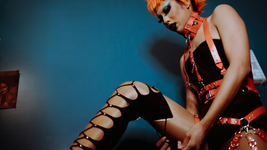Review: RE/SISTERS at the Barbican
- Talia Andrea
- Oct 4, 2023
- 4 min read
Updated: Jan 5, 2024
★★★☆☆

From tomorrow, the Barbican will publicly open its doors to RE/SISTERS: A Lens On Gender and Ecology. The exhibition, sponsored by Vestiaire Collective, aims to critically explore the fraught relationship between nature and gender across roughly 250 works.
The titular lens is pointed at women in particular, seeking to draw parallels between their implication in histories of colonial, capitalist and patriarchal exploitation, with the extraction and degradation of natural resources within these same systems. It is also designed to interrogate how and why women continually find themselves at the forefront of environmental campaigns and protests: this is an especially vital and contemporary line of enquiry, and one which is worth exploring.
Unfortunately, the exhibition does not actually offer much on this topic to explore. The layout initially looks promising: two floors organised in a circular fashion, featuring multimedia works from photography to painting to poetry, and then more photography for good measure.
However, the two floors feel like separate exhibitions: the slash in the RE/SISTERS title becomes more of an omen than an act of resignification. This is to say that the exhibit mostly splits the Re- — in its echoes of ecological renewal and re-generation — from the Sisters.
The ground floor features an array of images from Mabe Bethônico’s Speaking of Mud, which depicts the aftermath of two mining disasters in Brazil on the local landscape, to Mary Mattingly’s Cobalt Map, to Simryn Gill’s Channel series (photos 1-29). Photos of damaged terrain, detritus, and washed-up plastic shopping bags abound. These are powerful images without a doubt, but all of them left me with a lingering question: where exactly are the women?
You might say "behind the camera", and you’d of course be right, but at points it feels like the only thing tying gender to the ground floor is the fact that all of the works are produced by women. For an exhibition which claims at its core to negotiate and promote the visibility of women and non-binary people in relation to their environment, this is disappointing.
Much of the interaction between women and the environment is thus “offscreen”, left to the viewer's imagination. Carolina Caycedo’s Multiple Clitoris is slightly more on-the-nose, but it is undermined by its own blurb — as are many of the other works. According to said blurb, her images “invite the viewer to reflect on the fluidity of bodies of water, which resist the phallogocentric logic of extraction”. This was an invitation I chose to respectfully decline.
The flowery, inflated language used in many of the blurbs is emblematic of the exhibition as a whole, which attempts to thread together so many different strands of the gender-ecology relationship that it struggles to meaningfully elucidate any of them. Some of the pieces do show little twinkling signs of promise: Chloe Dewe Mathews’s photographs from Azerbaijan, Kazakhstan, Russia and Iran are some of the first to finally depict embodied women and their emotional and cultural connection to their land, from mountains and volcanoes to salt water and hot springs. Then they are immediately undermined by Sim Chi Yin’s Shifting Sands series installed nearby, which does make an interesting commentary on land ownership and reclamation, but once again does not visibly interact with themes of gender.
Other gems to be found within the ground floor’s curatorial rough include Khải Đơn’s poem The Island Decides To Disappear; Poulomi Basu’s striking photographic series Centralia, which bears witness to women’s role in the military resistance of corporate mining expansion in India; and an array of photographs of women taken at Greenham Common’s air base, during protests against nuclear armament. These moments of political engagement and provocation are arguably when the exhibition is at its most exciting; it is just a shame there aren’t more of them, for the curator’s favour of sped-up clips of wildlife and a “tongue-in-cheek” montage of an erupting volcano which — and I again had to read the blurb to discover this — is intended to recall and reappropriate the imagery of menstrual blood.
While both of the aforementioned works are in fact on the top floor, for the most part, once you climb the stairs, you’re finally afforded more of a glimpse of the titular Sisters. Here is where the exhibition really shines. Highlights include Pamela Singh’s Chipko Tree Huggers of the Himalayas, LaToya Ruby Frazier’s The Flint Water Treatment Plant and its related works, and chosen excerpts from The Grindmill Songs Project by the People’s Archive of Rural India. Some installations also offer an alluring view into a non-binary or genderfluid aesthetic, such as the cheerfully colourful sea-creature sculptures which accompany Anne Duk Hee Jordan’s film Ziggy and the Starfish, and Uýra’s photographic constructions, which simultaneously erase the binary lines between male/female and human/nature, as framed within the landscape of the Amazon region. Ada M. Patterson’s Looking For ‘Looking For Langston’ prints also neatly articulate the intersectional interactions between race, sexuality, nature and desire.
At this point, being confronted with images such as these makes you wonder why the exhibition doesn’t start, and stay, that way. The exhibition seems to pride itself on being globally sweeping and thematically multifaceted, but perhaps this is its downfall: a tighter focus on the intersection between the key themes of the exhibit, as in its last few rooms, would have given it the personal agency and political urgency which it sets out to achieve. As it is, although it is full of good art, and even great art, not even the excessively elaborate blurbs can make certain pieces feel like a meaningful part of the collection — which, ultimately, comes across as just as fragmented as its title.
RE/SISTERS is on at the Barbican from 5 October 2023 to 14 January 2024. Standard ticket price £16, student concession £11.50. Book your visit via the Barbican website.


































Comments